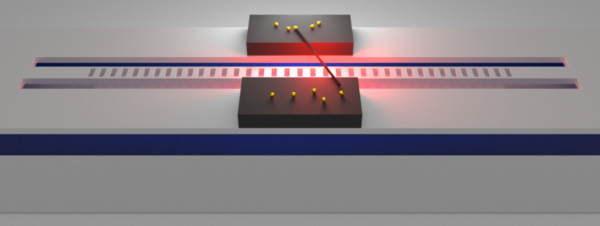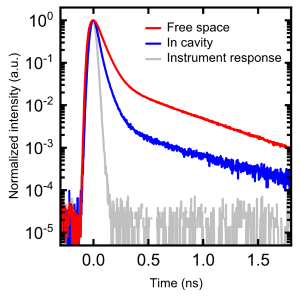Research:Near-unity radiative quantum efficiency of excitons in carbon nanotubes
Radiative quantum efficiency is one of the most important physical parameters that determines the efficiency of photonic devices. Semiconducting carbon nanotubes have a direct gap and are appealing as ultrasmall light emitters on the silicon photonics platform. Their efficiency is largely dependent on the quality of the nanotubes, and it has been difficult to determine the intrinsic properties of bright excitons. Here we experimentally determine the radiative quantum efficiency of pristine air-suspended carbon nanotubes by using a cavity quantum electrodynamical effect known as the Purcell effect. The Purcell effect selectively accelerates the radiative decay process, while the non-radiative processes remain unchanged. This allows us to evaluate the ratio of the radiative lifetime to the total lifetime, from which the radiative quantum efficiency can be obtained.

We have utilized air-mode nanobeam cavities that are known to efficiently couple to air-suspended carbon nanotubes. Since the efficiency of carbon nanotubes is reduced by direct contact with the silicon substrate, the tubes are grown from the spacers placed beside the nanobeam.

The decay lifetimes of the excitons are measured by time-resolved photoluminescence measurements. The excitons in carbon nanotubes decays in approximately 60 ps (red curve), but the cavity shortens the lifetime down to 30 ps (blue curve). Combined with the Purcell factor deduced from the photoluminescence spectra, the radiative quantum efficiency of the bright excitons is estimated by using the cavity quantum electrodynamical model. We find that the radiative quantum efficiency reaches 98% in this particular tube, and the high efficiency is reproducibly observed in 5 devices. Our findings show that the energy efficiency of nanotube-based photonic devices can be enhanced by improving the generation efficiencies of bright excitons.
To learn more about this work, please refer to
Evidence for near-unity radiative quantum efficiency of bright excitons in carbon nanotubes from the Purcell effect
Phys. Rev. Research
4, L022011 (2022).
![]()